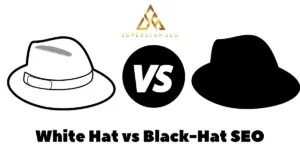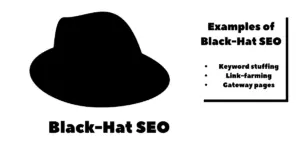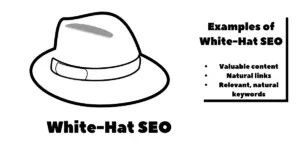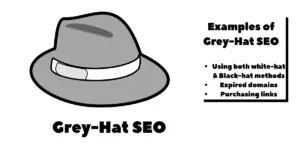One of the most commonly asked questions by people either getting into search engine optimization (SEO) or trying to hire a service is which type of SEO is best. Generally, the question is more about if white hat is better than black hat SEO and if it is possible to get away with so-called gray hat SEO.
While both approaches to SEO are with the same goal of ranking a website, they are based on very different strategies. Both approaches also have the potential for success if done right, but the black hat is considered riskier than white hat SEO. But it is possible to see results sooner with Blackhat SEO compared to using Whitehat SEO, which traditionally takes longer.
As a website owner, your goal for ranking it may be different from everyone else. Though generally, Whitehat SEO tends to be better for a business that wants to build long-term success and trust. However, as mentioned earlier, each approach has its own merits.
In this article, we’ll go over both SEO strategies. I’ll explain why and when one is better over the other.

Black Hat SEO
Black hat SEO, as you can probably guess, isn’t exactly something search engines like Google want people to engage in, but many do because it works. Black hat SEO exploits weaknesses in search giants’ algorithms. Usually, that means overly optimizing a page for visibility. However, it goes against guidelines published by search engines like Google.
A website owner may engage in black hat SEO mainly to get more attention from search engines than a human audience. Many people reading this may have at some point searched for something and landed on websites that are littered with ads and content that certainly does not make sense.
That’s why black hat SEO does not work for businesses that want to build a brand and lasting customer base, much less for marketing or targeted traffic.
Black hat SEO may help you rank well in a short time with practices like keyword stuffing, cloaking, and using gateway pages, but the rankings may not stick for long.
There are a few techniques that black hat SEOs rely on to rank websites, which I’ll briefly touch on below.

Irrelevant Keyword Use
This practice is also referred to as keyword stuffing and usually means filling a page with different keywords. Some just paste in the same keywords multiple times into different paragraphs of computer-generated text to trick the search engine into thinking the page is relevant to a searcher’s intent. However, the keywords aren’t relevant and offer no value.
A similar method used is called ‘cloaking,’ wherein a page uses keywords and low-quality content that are irrelevant to the page itself to divert search engines to rank for another set of terms. The page may have content for a car rental website, but the cloaked keywords are used to rank it for auto parts-related search terms.
Search engines see a separate set of terms compared to users from whom these terms are hidden or cloaked.
Link Farming
Now this refers to having a group of websites that link to each other to increase rankings. Even though the links don’t provide traffic to the site they link to, they help the site show up in search results. Depending on how good the links are, it can significantly increase rankings and push a page closer to the top.
While there is significant data to suggest that link farming works, Google strongly forbids link farming, and websites regularly get penalized for what’s referred to as unnatural linking. Again here, if it is a website you don’t care to lose and just want that one-time boost in rankings to run a scam, perhaps then this might be the way to do it. But everyone else should stay away from it.
Gateway Pages
Gateway pages work by redirecting visitors from a legitimate website, which ranks well to another website with low-quality content.
Often search engines may see the legitimate page, which helps it avoid getting penalized. At the same time, visitors are taken to the page that they want to otherwise show usually invisible to the search engine, but which is never relevant to what the person was searching for in the first place.
Above aren’t the only black hat strategies used. But it should give you some idea as to how it works and why you should probably not invest in it if you want to build a legitimate business.
It is best to steer clear of deceitful strategies, which brings us to white hat SEO below.
White Hat SEO
Now, this is so-called good SEO. We recommend using white hat SEO because it uses best practices to rank websites by providing valuable content and following Google’s guidelines. White hat SEO can help improve your website’s visibility for a particular key phrase or a set of phrases or keywords as they are called.
So, anyone who searches using those keywords either in their entirety or in part should be able to find your website, visit and possibly buy from it.
A big part of white hat SEO is ensuring that visitors from search engines like google, have a good experience. SEOs will run audits to find broken links, issues with the existing content and look for ways to get high-quality organic backlinks from related websites.
Below we’ll go into a handful of white hat SEO techniques. The list below is by no means exhaustive, but it’s meant to show you what white hat SEO entails.

Relevant Use of Keywords
Keywords are a big part of increasing your page’s visibility because just about everyone uses a keyword or phrase to search the internet. Search engines scan websites/web pages for keywords to help show the page in order of relevance.
Keyword research can get extremely complex. You can also end up with hundreds of relevant keywords, something which we’ll not get into here. However, suffice to say that multiple tools, both free and paid, can help you with keyword research. Once you have a set of keywords, your next step would be to optimize your website for those keywords. Every search engine optimization guru has its own way of doing things but it’s mostly a set of best practices.
Value
The value is directly linked to the content you’re putting out and what you offer. Search engines like Google don’t just scan for keywords but also for the relevance of the site so that it can be recommended to those searching.
If search engines see that your site is well matched to the intention of the people searching using those keywords, it’s going to rank you higher. The best way to ensure relevancy is to provide valuable and honest content. Slowey adds more content, which in the long-term will grow the website and help your site build a reputation, ensuring lasting revenue.
You May Also Like: How To Do SEO For a New Website
Draft Engaging Titles
Now engaging titles are what will help you get noticed by human readers.
Engaging titles for your YouTube videos and articles are also going to be an important part of your marketing strategy but it takes some thought. While black hat SEO holds titles in lower regard compared to a few years ago when they were important for ranking well, today, having a good, catchy title continues to be important to help get searchers’ attention.
The title should describe what the page is about while ensuring that it has the keyword you’re trying to rank for in it. However, make sure that the title entices someone to read the article or what you’re offering. Keep it honest, relevant, and catchy but ensure that you make good on what you promised in the title. In other words, refrain from hyperbole.
Gray Hat SEO
Gray hat SEO is a sort of middle-of-the-road approach to SEO. It is said to be as safe as white hat SEO but uses what works for black hat SEO. I tend to look at it as being riskier as compared to white hat SEO but is not as likely to get you penalized.
Gray hat SEO consists of various techniques, some of which, like cloaking, are also used in black hat SEO. Below we’ll take a brief look at a couple of gray hat SEO techniques.

Old Domains
Many gray hat SEOs will pickup old domains, ideally ones with a good reputation, and have them redirected to their main website. Another method is to have the old domains repurposed into websites, often with content that’s recreated from the WayBackMachine, and then, creating backlinks to the main site. If the domains are authoritative, then they tend to pass quite a bit of authority, helping businesses in often challenging industries rank.
Duplicate Content
Content is not everything, but it still means a lot in the way of SEO efforts. Gray hat SEOs use text spinners to repurpose existing content into often incomprehensible gibberish but which appear to be unique to search engines. While I don’t think the technique is as effective as it used to, the gray hat SEO community still uses it for some projects.
Purchasing Links
Gray hat SEOs, purchase their links instead of acquiring them organically like through outreach or HARO, etc. However, while buying links is considered gray hat because Google forbids this practice and has penalized websites for it, it is still an effective way of ranking well if done right.
If you are going to buy “do-follow” backlinks, they should be from reputed sellers. The links should also be from websites that are related to your niche. If the link adds value and is from a somewhat popular website with traffic, it will do your SEO a great deal of good.
Google can’t tell if a link was purchased, but it can tell if links follow a particular pattern associated with link farms or sites that sell links. If it sees that pattern on certain websites, it suspects that links are being sold, and then action is taken accordingly which can be anything.
Related: How To Build Backlinks For Beginners
So, the question is, What Type of Long Term SEO Strategy is Best?
You’ve probably already guessed it.
White hat SEO is the best long-term strategy for any business that wants to continue to grow their website and consequently sales. Ranking a website organically using white hat methods takes time and can sometimes be frustrating. Still, it’s a sure thing because at least Google, your source for the most traffic in almost any industry, isn’t going to penalize you.
If anything it pays to stay on Google’s good side!
However, all approaches can work well and it depends on the situation to pick a winner. For example, if you’re creating 100 different sites with the goal being to rank any of them as quickly as possible without a lot of long term goals, a black-hat approach may be best.
Or if you know how to mitigate the risks, a grey-hat approach might be the most effective. It all depends on your situation. There are people who have major success with all types of SEO, and it’s about what’s best for you.
Read More on SEO
If you would like to read more on SEO, check out some of my recent posts below.





